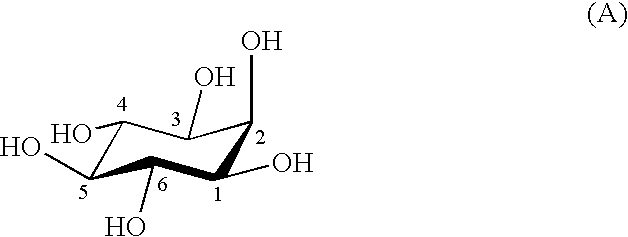Process for producing scyllo-inositol
a technology of scylloinositol and process, which is applied in the direction of sugar derivates, organic chemistry, enzymology, etc., can solve the problems of low substrate concentration, low method application, and inability to study the detailed mechanism of the method, etc., and achieve high yield
- Summary
- Abstract
- Description
- Claims
- Application Information
AI Technical Summary
Benefits of technology
Problems solved by technology
Method used
Image
Examples
example 1
[0347] 3 L of a liquid medium containing 10.0% myo-inositol, 1.0% yeast extract, and 1.0% sucrose was adjusted to pH 7.0 with 1N NaOH, and the medium was dispensed in 100 ml aliquots into 30 pieces of 500 ml-volume baffled conical flasks, followed by sterilization using an autoclave. One platinum loop of a slant culture of Acetobacter sp. AB10281 strain (FERM BP-10119) was inoculated to each of the conical flasks, and the microorganism was cultured at 27° C. for 5 days in a rotary shaker. After the culture, 250 ml of water was added to each of the conical flasks, and the mixture was stirred for 1 hour in a rotary shaker to dissolve crystalline scyllo-inositol generated in the culture solution. The culture solution was collected and centrifuged (8,000 rpm 20 minutes), and the obtained supernatant was defined as a culture supernatant solution (10.2 L).
[0348] The culture supernatant solution was analyzed by high-performance liquid chromatography under the following conditions. The res...
example 2
[0362] 40 L of a liquid medium containing 10.0% myo-inositol, 1.0% yeast extract, and 1.0% sucrose was poured in a 50-L jar fermentor and adjusted to pH 7.0 with 1N NaOH, followed by sterilization using an autoclave. 400 ml ofAcetobacter sp. AB10281 (FERM BP-10119), which had been cultured in a medium having the same composition (conical flask), was inoculated and cultured at 27° C. for 5 days at an aeration rate of 1 vvm and an agitation of 200 rpm. After the culture, 60 L of hot water (about 50° C.) was added to about 40 L of the collected culture solution, and the mixture was stirred for 1 hour to dissolve crystalline scyllo-inositol which had been present in the culture solution. The culture solution was subjected to continuous centrifugation (8,000 rpm) to remove the cells, and the resultant solution was defined as a solution from which the cultured microorganism had been removed (about 100 L).
[0363] The solution from which the cultured microorganism had been removed was analy...
example 3
[0367] The nucleotide sequences of 16SrRNA were analyzed for 4 microbial strains consisting of 3 natural isolated strains, AB10285, AB10286, and AB10287, each having an ability to convert myo-inositol into scyllo-inositol, and AB10281 obtained from AB10253, in accordance with the conventional method. More specifically, a genomic DNA was extracted from the cultured cells, and then corresponding DNA fragments were prepared by the PCR using primers that were designed so as to amplify about 1.6 kbp of 16SrRNA, followed by analysis of about 1.3 kbp of sequences (Hokkaido System Science Co., Ltd.). The results of the sequences were inquired against database to identify related species.
[0368] Table 2 shows the inquiry results, homologies, and conversion rates into scyllo-inositol in culturing the microorganisms in the same way as Example 1.
[0369] Identification of Microbial Strains by Analysis of 16SrRNA Nucleotide Sequence
TABLE 2StrainName ofConversionnameidentified microorganismsHomo...
PUM
| Property | Measurement | Unit |
|---|---|---|
| pH | aaaaa | aaaaa |
| pH | aaaaa | aaaaa |
| pH | aaaaa | aaaaa |
Abstract
Description
Claims
Application Information
 Login to View More
Login to View More - R&D
- Intellectual Property
- Life Sciences
- Materials
- Tech Scout
- Unparalleled Data Quality
- Higher Quality Content
- 60% Fewer Hallucinations
Browse by: Latest US Patents, China's latest patents, Technical Efficacy Thesaurus, Application Domain, Technology Topic, Popular Technical Reports.
© 2025 PatSnap. All rights reserved.Legal|Privacy policy|Modern Slavery Act Transparency Statement|Sitemap|About US| Contact US: help@patsnap.com



